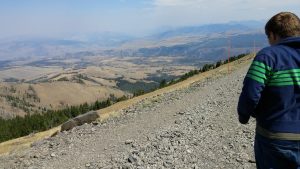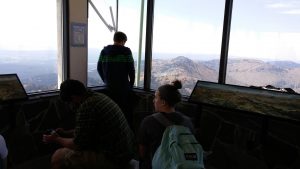In Wyoming this past summer we had the opportunity to climb Mt. Washburn (elevation 10,219 feet), a mountain renowned for the winds whipping around its slopes, often at speeds of 20-30 miles per hour; at the summit, the gusts blow even harder.
Sensory Challenges

It’s one thing to read about strong winds; it’s another thing to experience them on your way up a high mountain. The wind and powerful gusts posed new sensory challenges to my son as we climbed, not only the sensation of blowing air, but the noise and roaring.
To get my son Douglas up and down the mountain I saw right away that he would need extra supports, especially since his reaction to the buffeting wind was to stand stock still, scrunch up his face and shoulders, and not move! Clearly he was enjoying the wind, but we also had to move along.
The tag point to address this situation was obvious: Take Next Step.
Going too slowly
Although I knew how to address the problem, I hadn’t expected the lengthy “stand still” reactions to the wind. My concern was that it would take so long to do the hike that we would be late with his food schedule and that he would become hungry and upset. This concern only worsened when we were well up the trail and I realized that he had already eaten the snacks in the back pack while we were in the car!
We kept going. As we dawdled along, I tagged and reinforced him every time he took the next step, until finally our pace picked up and we made slow, steady progress along the trail. We enjoyed the spectacular views and had pleasant chats with the many families and groups who power-walked past us. Everyone marveled at the wind.
Reaching the peak and the kindness of strangers
 After being almost knocked off our feet by the howling winds of the final ascent, we scrambled our way into the shelter at the top. There we were, windblown, hungry, and foodless. Luckily, a number of people who had passed us along the way spotted us and very kindly offered Douglas snacks and drinks from their backpacks. I was very grateful.
After being almost knocked off our feet by the howling winds of the final ascent, we scrambled our way into the shelter at the top. There we were, windblown, hungry, and foodless. Luckily, a number of people who had passed us along the way spotted us and very kindly offered Douglas snacks and drinks from their backpacks. I was very grateful.
It all worked out
Thanks to positive behavioral supports and the kindness of fellow hikers, we had the wonderful, once-in-a-lifetime experience of climbing the highest peak in Yellowstone – a dream come true.
TAGteach is a great tool for dealing with unexpected sensory issues: look at the sensory challenge, set a tag point for a desired behavior that the child can do (or is already doing), and tag and reinforce intensively. Naturally, if a situation is too difficult, re-assess and make appropriate changes.
It would have been so easy to bail out of this hike from frustration because we spent a lot of time standing still and going nowhere; yet with patience, persistence, and positive reinforcement we made it to the top.
What is TAGteach?
TAGteach stands for Teaching with Acoustical Guidance. TAGteach is a teaching and communication method based on the scientific principles of Applied Behavior Analysis (ABA).
TAGteach enables extremely precise positive reinforcement of behavior by using an acoustical signal to “mark” the behavior – at the precise moment the child performs the behavior! The acoustical signal is a short, sharp sound made by a handheld device (the “tagger”). When the child performs the correct action, the parent/instructor immediately presses the button on the tagger and hands over a treat (candy, treat, token, praise, social recognition, or money) as a reinforcer.
With TAGteach, it is easy to reinforce behaviors precisely, quickly, and intensively. The immediate, accurate feedback and positive reinforcement result in the child performing the correct action more often, and for longer periods of time. With immediate feedback and learning tasks broken down into small steps, children (and adults) can learn many new skills with TAGteach — at their own pace.
 To learn more about this effective, low-cost method visit TAGteach International or Chaos to Calm
To learn more about this effective, low-cost method visit TAGteach International or Chaos to Calm
Join the free TAGteach for Learning, Behavior, and Autism Facebook group
TAGteach taggers available here and i-Clicks available here
See Martha’s book about TAGteach for Autism or feel free to ask me a question (with no obligation).
Sign up for my mailing list to receive updates, new articles and free tips right in your inbox!
If you liked this post, please share it. Thank you!

